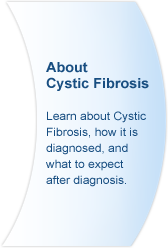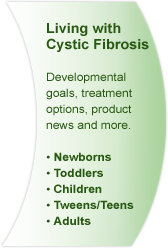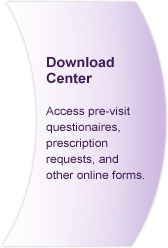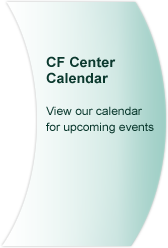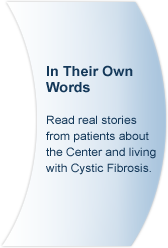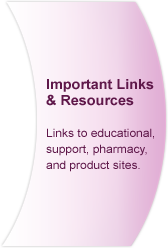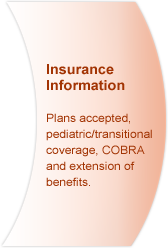|
|||||||
 |
 
CHILDREN (Ages 4-7)Find helpful resources to help your child and family live with CF and issues relating to school and exercise. 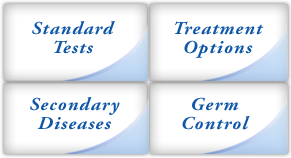
Latest NewsElectronic Medical Records: We're pleased to announce that Electronic Medical Records (EMR) went live in the Pediatric Center on November 24, 2013. We can now order your medications online, and all the doctors who see a patient within the health system can see important data on the patient, improving the quality of multidisciplinary care. Parenting Children with Cystic Fibrosis CF parents face a unique set of challenges - keeping up with treatments, clinic visits and daily activities can be frustrating, tiresome and isolating. Parenting Children with Health Issues is based on the Love and Logic parenting program developed by child psychologists and parents of children with CF. Click here for more information. Cystic Fibrosis and Constipation in Children: An Underestimated Medical Condition A recent investigation of 214 pediatric CF patients revealed that 47 percent of the CF children studied have constipation. Furthermore, 106 abdominal radiographs were independently assessed utilizing the Barr and Leech scores to determine the test's diagnostic value. The study concluded that constipation is a significant medical issue in CF and was associated with low total fat absorption and a history of meconium ileus; and that abdominal radiography seems of little value in the regular follow-up of CF patients. Source: Constipation in pediatric cystic fibrosis patients: an underestimated medical condition. J Cyst Fibros 2010 Jan; 9(1):59-63. NutritionFour- to seven-year-olds are better at chewing, swallowing, using utensils, and sticking with the task of eating than toddlers. Children this age with CF have higher nutritional needs than those without the disease - they need more calories, enzymes to digest and absorb food, vitamins and salt.Children in this age group learn by watching their family, parents, teachers and friends. They like to be independent, but need limits and structure. This applies to nutrition, too - so plan meals and snacks and have clear rules about what children can eat at mealtime. The CF dietician or care provider will teach you how to incorporate these requirements in your child's diet, and you can find more information here. If a child in this age group has CF, he or she may need 2,000 to 2,800 calories a day. A balanced diet is essential, not just for your child with CF, but for the whole family. Since four- to seven-year-olds with CF will eat the same amount as other children, they require more calories added to their diet. As with toddlers, give whole milk and whole milk dairy products, and add cream, butter and extra cheese where you can. Vitamin supplements are crucial because of the malabsorption of vitamins in CF. As with toddlers, enzymes and extra salt are also needed, and some children may need tube feedings to gain weight and grow. Meals away from home At this age, your child may eat meals at other homes, at daycare or in school. Teach people how and when to give enzymes and plan high-calorie meals and snacks. Send enzymes to school or daycare with the proper paperwork (your CF dietician or care provider can help with the paperwork). Most four- to-seven-year-olds still need the enzyme capsules opened and the beads mixed with food. They will still need supervision and help with enzymes for a few more years. You can help with meals away from home by sending the enzymes and the acidic food (like applesauce or other fruit) to mix them with. Enzymes should not be mixed in food ahead of time. Meal planning Rather than planning special meals for your CF child, you should plan one menu for the entire family. Your CF dietician will help you change your family's current meals to put extra calories on the plate of the child with CF. There are also store-brought products to help with weight gain that you can add to snacks or at mealtime. Some foods you can use to add calories are whole milk, cream, cheese, butter, cream cheese, sour cream, powdered milk, oil, peanut butter, salad dressing and mayonnaise. Do not use "light" or "low-fat" products. SchoolWhen people with CF attend school, they may need special permissions, services or changes from the school to maintain their health. For instance, some people with CF may need to take medicines at school without going to the nurse's office, have a plan to get homework or a tutor when ill or in the hospital, or have attendance rules waived or adjusted.Public School Many children with CF find that attending school with their friends prepares them for the future. If your child goes to school, it is vital to work with the school to help meet your child's daily health needs. To do this, you may need an Individual Education Plan (IEP) under the Individuals with Disabilities Education Act (IDEA) or a 504 plan under Section 504 of the Rehabilitation Act of 1973. The IDEA is a federal law that makes public elementary and secondary schools give free and appropriate education to children with disabilities. Section 504 is a federal law that prohibits discrimination against a person because of a disability by any group that gets federal funds. An IEP or 504 plan outlines how absences or medical treatments will be managed by the school. To get an IEP or 504 plan, contact your child's school, preferably at the start of each school year. Contact the teacher, administrator or school nurse and ask for an evaluation of your child under the IDEA or Section 504 of the Rehabilitation Act. Our office has a sample letter that you can use to explain to the school how CF affects your child and to identify some school accommodations that may help. We can also offer advice on how the school can help you meet your child's learning and healthcare needs. Not all parents want to have a written IEP or 504 plan; some may just want a verbal agreement with the school so the child can take medicines at school. But without a written plan, the school does not have to honor the agreement. Under the IDEA, students qualify for services if their disability affects their ability to learn - such as when your child is absent from school due to illness and needs a tutor. The school may not agree that having CF qualifies your child from having IDEA services. Then you should ask that your child be evaluated under Section 504 or the Rehabilitation Act of 1973. Section 504 requires the student to have a disability that substantially limits a major life activity. Many people with CF qualify for services because their ability to breathe or digest food is limited - so Section 504 should give your child the changes needed to benefit from school. If your child is denied services, your CF care team can help with an appeal. Private School If your child chooses to attend a private school, talk to school administrators, teachers and other students to learn how flexible the school is in meeting the needs of people with CF or other health conditions. Private schools that do not get federal funding do not have to follow the IDEA or Section 504. But the ADA may help students with CF get changes or accommodations at a private school. Most students with CF meet the ADA's definition of a person with a disability because they are substantially limited in major life activities such as breathing and digesting food. Your CF care center can help you document your or your child's needs in order to request school accommodations. A private school that does not get federal funding may decide not to accept a student because of the need for accommodations. It is against the law for a school that gets federal funds to refuse to accept someone because of requested health accommodations. But, it could happen. You do not need to disclose health needs unless and until you need or request accommodations. Your CF team can help you decide what and when to tell the school. If you are denied changes, you can file a complaint with the U.S. Department of Justice. What Teachers Should Know One of the most common problems in the CF classroom is the hacking cough that a CF child experiences. Some of the other children may feel that the CF child is spreading germs. This is not true; CF is not contagious, and the cough is the body's defense system against chronic infections. The other students in your class will not "catch CF." It's a big help for students to discuss CF openly so that everyone is aware of what is happening. Students should not be embarrassed about coughing in class, and should feel free to leave class until the coughing attack is over, or keep a glass of water nearby to soothe a persistent cough. It may also be helpful for the student to keep a box of tissues at his or her desk or at the teacher's desk. Remember, the CF student needs to cough and expel the mucus. Teachers should also understand that coughing at night might prevent a child from getting a good night's sleep, and the child might not be able to stay awake in class or need extra time to get assignments done. Because of the digestive problems that this disease causes, your CF student will need special consideration with restroom privileges. CF causes frequent bowel movements, along with a feeling of urgency. To avoid embarrassment, teachers should be asked to allow a child with CF to leave the classroom at any time to use the restroom. A CF child may also be too tired to participate in gym activities. Teachers can make the child feel included by letting him or her keep score, collect equipment or help in some other way. Sometimes a CF child may miss several days because of a severe lung infection. The teacher can send home the child's assignments and work with the child's tutor, if required. When the CF child is in the hospital, the hospital tutor may contact the teacher to get assignments and direction. It is important for parents, teachers, and administrators to meet early in the school year and communicate periodically as to how the child is doing in class. Other ways a teacher can help is to ask the parent or child to make a presentation to the class about cystic fibrosis, or ask the class to help with CF fundraisers. It would be particularly helpful to schedule a few minutes of extra time periodically with the CF child so that the teacher is aware of the child's struggles and feelings in coping with the disease, keeping up with class work and fitting in with other children. The CF care professionals at North Shore-Long Island Jewish Hospital are always willing to work with your child's teachers. Prevention of IllnessIt is always better to prevent health problems than to have to treat them after they have occurred. Your child should receive all immunizations and an annual flu shot. Many childhood illnesses and flu can affect the lungs, causing serious problems for the person with CF, so preventing illnesses through immunization is very important.Like other children, your child should avoid unnecessary contact with anyone who has a cold or other contagious illness. But this does not mean that your child should be kept home from school or have activities limited because you are afraid your child will get sick or "catch something." It is just not possible to prevent exposure to all germs. Besides, your child's mental and emotional growth and development depend upon a normal, healthy interaction with the surrounding world. There are some preventive measures you should take, however. For example, your child should not have a prolonged playtime or a sleepover at the home of a child who has a cold or other contagious illness. Also, toys passed along to your child from another should be cleaned. This can be done by soaking them for 10 minutes in a solution of chlorine bleach and water (1/4 cup bleach in 1 gallon water) and rinsed in plain water. Soft toys should be put through the washing machine regularly. If your child is in daycare, check on how often the toys at the daycare center are cleaned. Also, beware of indoor play areas at malls and other places where a lot of children pass through and the cleaning may be less than ideal. Some of the risks of the surrounding world can be reduced by a simple remedy - regular washing of hands by the person with CF, parents, and brothers and sisters. Hands should be washed before eating meals or snacks; after going to the bathroom; after blowing the nose or coughing; when coming inside the house after being outside at school, play or work; after traveling on the bus or train; after being with someone who is sick. If soap and water is not handy, keep individually wrapped "wipes" with you and perhaps in the car as well. Please do not smoke in your home or car if you have a child with CF, and do not allow others to do so. Learn more about preventing illness here. How to Talk to Your Child about CFChildren's first questions about CF often come up after they enter school. They may become aware that other children don't take enzymes or do CPT every day. Or, they may be asked questions about CF by other children or by teachers or parents of other children.The goals of telling your child about CF are to help the child understand what CF means; why eating right, taking enzymes and other medicines and doing CPT are important; and to start getting the child ready to manage his or her own care. The most difficult question is about death. Other children may have heard that CF is fatal disease of childhood, which it once was. One mother explained it this way: "We told him, 'There are a lot of ways a person can die. We don't know if you will die from CF or not. Right now, you have medicines that help keep you well. If you take your medicines and do what you are supposed to do, you will probably be OK, but CF is something you will have for the rest of your life.'" All children should be taught about CF as soon as they are able to understand. What you say to your child depends on his age, personality, and ability to understand. If you have questions, ask a member of your Cystic Fibrosis Center team. You can also teach your child how to talk about their CF. The goal is to talk about it in a matter-of-fact way. For example, "I take enzymes to help my body digest food." "I do chest physical therapy to clear my lungs." "The reason I cough is to help the lung problem I have." Handling Unwanted QuestionsJust because your child has CF doesn't mean you have to open up your life to every person who passes by. Teach people about CF but remember that you and your family have a right to privacy. Unfortunately, you will probably have to deal with unwanted questions from concerned or just nosy people who might, for example, comment on your child's cough while standing in line at the grocery checkout. Some suggestions for dealing with unwanted questions include ignoring them, smiling politely and shrugging, saying "my child has a lung disorder that causes coughing," or saying that your child has CF and explaining a little about it.Treatment OptionsClick here for important information on treating your child's cough or cold.Postural Drainage and Percussion Postural Drainage and Percussion (PD & P), also known as chest physical therapy, is a widely accepted technique for helping people with CF breathe with less difficulty and stay healthy. PD & P uses gravity and percussion to loosen the thick, sticky mucus in the lungs so it can be removed by coughing. Unclogging the airways is critical to reducing the severity of lung infections. The goal of PD & P is to clear mucus from each of the five lobes of the lungs by draining mucus into the larger airways so it can be coughed out. The right lung is composed of three lobes: upper, middle and lower, while the left lung has two lobes: upper and lower. The lobes are divided into smaller divisions called segments. The left and right upper lobes are made up of three segments each: apical, posterior and anterior. The left upper lobe also includes the lingual, which corresponds to the middle lobe on the right. The lower lobes each include four segments: superior, anterior, lateral basal and posterior basal. Each segment of the lung contains a network of air tubes, air sacs and blood vessels. These sacs allow for the exchange and carbon dioxide between the blood and air. These are the segments that PD & P seeks to drain. Performing PD & P In young children, PD & P must be performed by a caregiver. PD & P involves a combination of techniques including multiple bronchial drainage positions, percussion, vibration, deep breathing and coughing that help move mucus from the lungs to the throat. Once the child is in one of the several prescribed drainage positions, the caregiver performs percussion on the chest wall. Here are the positions for performing PD & P on children and the lung sections that each one targets. Child/Upper Lobes/Apical Segments: The child sits on the flat drainage table and leans backward on a pillow at a 30-degree angle. Stand behind the child and percuss and vibrate over the muscular area between the collarbone and the top of the shoulder blade on both the left and right sides. |
||||||
